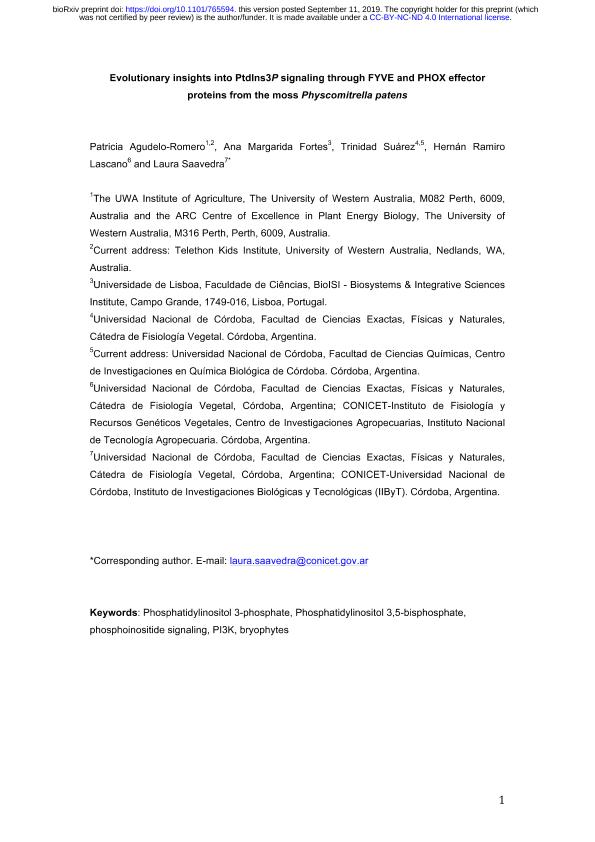Mostrar el registro sencillo del ítem
dc.contributor.author
Agudelo Romero, Patricia
dc.contributor.author
Fortes, Ana Margarida
dc.contributor.author
Suárez, Trinidad

dc.contributor.author
Lascano, Hernan Ramiro

dc.contributor.author
Saavedra Borelli, Laura Lucía

dc.date.available
2020-08-28T14:23:28Z
dc.date.issued
2020-02-10
dc.identifier.citation
Agudelo Romero, Patricia; Fortes, Ana Margarida; Suárez, Trinidad; Lascano, Hernan Ramiro; Saavedra Borelli, Laura Lucía; Evolutionary insights into FYVE and PHOX effector proteins from the moss Physcomitrella patens; Springer; Planta; 251; 62; 10-2-2020; 1-20
dc.identifier.issn
0032-0935
dc.identifier.uri
http://hdl.handle.net/11336/112612
dc.description.abstract
Phosphatidylinositol 3-phosphate (PtdIns3P) is a signaling phospholipid, which regulates several aspects of plant growth and development, as well as responses to biotic and abiotic stresses. The mechanistic insights underlying PtdIns3P mode of action, specifcally through efector proteins have been partially explored in plants, with main focus on Arabidopsis thaliana. In this study, we searched for genes coding for PtdIns3P-binding proteins such as FYVE and PHOX domaincontaining sequences from diferent photosynthetic organisms to gather evolutionary insights on these phosphoinositide binding domains, followed by an in silico characterization of the FYVE and PHOX gene families in the moss Physcomitrella patens. Phylogenetic analysis showed that PpFYVE proteins can be grouped in 7 subclasses, with an additional subclass whose FYVE domain was lost during evolution to higher plants. On the other hand, PpPHOX proteins are classifed into 5 subclasses. Expression analyses based on RNAseq data together with the analysis of cis-acting regulatory elements and transcription factor (TF) binding sites in promoter regions suggest the importance of these proteins in regulating stress responses but mainly developmental processes in P. patens. The results provide valuable information and robust candidate genes for future functional analysis aiming to further explore the role of this signaling pathway mainly during growth and development of tip growing cells and during the transition from 2 to 3D growth. These studies would identify ancestral regulatory players undertaken during plant evolution.
dc.format
application/pdf
dc.language.iso
eng
dc.publisher
Springer

dc.rights
info:eu-repo/semantics/openAccess
dc.rights.uri
https://creativecommons.org/licenses/by-nc-nd/2.5/ar/
dc.subject
BRYOPHYTES
dc.subject
PHOSPHATIDYLINOSITOL 3-PHOSPHATE
dc.subject
PHOSPHATIDYLINOSITOL 3,5 -BIPHOSPHATE
dc.subject
PHOSPHOINOSITIDES
dc.subject
VESICLE TRAFCKING
dc.subject.classification
Bioquímica y Biología Molecular

dc.subject.classification
Ciencias Biológicas

dc.subject.classification
CIENCIAS NATURALES Y EXACTAS

dc.title
Evolutionary insights into FYVE and PHOX effector proteins from the moss Physcomitrella patens
dc.type
info:eu-repo/semantics/article
dc.type
info:ar-repo/semantics/artículo
dc.type
info:eu-repo/semantics/publishedVersion
dc.date.updated
2020-05-07T14:23:16Z
dc.identifier.eissn
1432-2048
dc.journal.volume
251
dc.journal.number
62
dc.journal.pagination
1-20
dc.journal.pais
Alemania

dc.journal.ciudad
Berlin
dc.description.fil
Fil: Agudelo Romero, Patricia. University Of Western Australia. Faculty Of Science. Centre Of Excellence In Plant Energy Biology.; Australia
dc.description.fil
Fil: Fortes, Ana Margarida. Universidade de Lisboa; Portugal
dc.description.fil
Fil: Suárez, Trinidad. Consejo Nacional de Investigaciones Científicas y Técnicas. Centro Científico Tecnológico Conicet - Córdoba. Centro de Investigaciones en Química Biológica de Córdoba. Universidad Nacional de Córdoba. Facultad de Ciencias Químicas. Centro de Investigaciones en Química Biológica de Córdoba; Argentina. Universidad Nacional de Córdoba. Facultad de Ciencias Exactas Físicas y Naturales. Departamento de Fisiología; Argentina
dc.description.fil
Fil: Lascano, Hernan Ramiro. Instituto Nacional de Tecnologia Agropecuaria. Centro de Investigaciones Agropecuarias. Unidad de Estudios Agropecuarios. - Consejo Nacional de Investigaciones Cientificas y Tecnicas. Centro Cientifico Tecnologico Conicet - Cordoba. Unidad de Estudios Agropecuarios.; Argentina. Universidad Nacional de Córdoba. Facultad de Ciencias Exactas Físicas y Naturales. Departamento de Fisiología; Argentina
dc.description.fil
Fil: Saavedra Borelli, Laura Lucía. Universidad Nacional de Córdoba. Facultad de Ciencias Exactas Físicas y Naturales. Departamento de Fisiología; Argentina. Consejo Nacional de Investigaciones Científicas y Técnicas. Centro Científico Tecnológico Conicet - Córdoba. Instituto de Investigaciones Biológicas y Tecnológicas. Universidad Nacional de Córdoba. Facultad de Ciencias Exactas, Físicas y Naturales. Instituto de Investigaciones Biológicas y Tecnológicas; Argentina
dc.journal.title
Planta

dc.relation.alternativeid
info:eu-repo/semantics/altIdentifier/url/https://link.springer.com/article/10.1007/s00425-020-03354-w
dc.relation.alternativeid
info:eu-repo/semantics/altIdentifier/doi/https://doi.org/10.1007/s00425-020-03354-w
dc.relation.alternativeid
info:eu-repo/semantics/altIdentifier/url/https://www.biorxiv.org/content/10.1101/765594v1
dc.relation.alternativeid
info:eu-repo/semantics/altIdentifier/url/https://repositorio.inta.gob.ar/xmlui/handle/20.500.12123/7067
Archivos asociados
